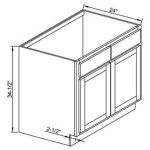Should I Use Oil-Based Paint on Kitchen Cabinets?
The decision of whether to use oil-based paint on kitchen cabinets is a significant one that impacts the longevity, appearance, and maintenance requirements of the painted surface. Both oil-based and water-based (latex) paints have distinct characteristics, each with advantages and disadvantages relevant to kitchen cabinet applications. Understanding these properties is crucial for making an informed choice that aligns with project goals and desired outcomes.
Kitchen cabinets endure substantial wear and tear. They are subjected to frequent cleaning, humidity fluctuations, and potential impacts from cookware and utensils. The paint chosen must withstand these challenges while maintaining an aesthetically pleasing finish. Therefore, the selection process necessitates a careful evaluation of factors such as durability, ease of application, drying time, environmental impact, and overall cost.
Oil-based paints, also known as alkyd paints, have historically been a popular choice for cabinetry and trim due to their inherent hardness and ability to create a smooth, enamel-like finish. However, advancements in water-based paint technology have led to significant improvements in their performance, challenging the traditional dominance of oil-based paints in this application.
Durability and Finish Quality
One of the primary reasons for considering oil-based paint for kitchen cabinets is its reputed durability. Oil-based paints typically form a harder, more resilient film compared to many traditional latex paints. This increased hardness offers better resistance to scratches, chips, and abrasions, which are common occurrences in a high-traffic kitchen environment. The hardened film is also less prone to water damage, making it a suitable option for areas with high humidity or potential spills.
Furthermore, oil-based paints tend to level out more effectively during the drying process. This self-leveling property results in a smoother, less textured finish, often described as enamel-like. The smooth surface is not only visually appealing but also easier to clean, as there are fewer crevices for dirt and grime to accumulate. This is particularly important for kitchen cabinets, which are susceptible to grease splatters and food stains.
However, it is essential to note that the durability gap between oil-based and high-quality water-based paints has narrowed considerably. Modern acrylic latex paints, especially those formulated specifically for cabinets and trim, offer comparable scratch and chip resistance while boasting other advantages. The long-term durability of any paint, regardless of its base, depends heavily on proper surface preparation, including thorough cleaning, sanding, and priming.
The gloss level of oil-based paint also contributes to its perceived durability and cleanability. Oil-based paints are available in a range of sheens, from matte to high gloss, but they generally maintain their sheen level better than water-based paints over time. A higher gloss finish reflects more light and is easier to wipe clean, making it a practical choice for kitchen cabinets that require frequent cleaning. However, high-gloss finishes also accentuate imperfections in the underlying surface, so meticulous surface preparation is crucial.
Application and Drying Time
The application of oil-based paint differs significantly from that of water-based paint. Oil-based paints typically require the use of mineral spirits or paint thinner for thinning and cleanup, which can be more cumbersome and require careful handling. These solvents have a strong odor and release volatile organic compounds (VOCs) into the air, posing potential health concerns and environmental risks. Proper ventilation is essential during application and drying to minimize exposure to VOCs.
Furthermore, oil-based paints tend to have a longer drying time compared to water-based paints. This extended drying time can be a disadvantage for projects with tight deadlines or when minimizing disruption to the kitchen is a priority. Multiple coats of oil-based paint may require several days to fully dry and cure, prolonging the overall painting process. The slow drying also increases the likelihood of dust or debris settling on the wet paint, potentially affecting the final finish quality.
Application techniques also differ between oil-based and water-based paints. Oil-based paints typically require more careful application to avoid brushstrokes and drips. While the self-leveling properties of oil-based paint help to minimize brush marks, achieving a flawless finish often requires a skilled hand or the use of a sprayer. The use of proper brushes and rollers specifically designed for oil-based paints is also crucial for achieving optimal results.
In contrast, water-based paints dry much faster, allowing for quicker recoating and faster project completion. Cleanup is also simpler, requiring only soap and water rather than solvents. The lower VOC content of water-based paints makes them a more environmentally friendly choice and reduces the risk of health problems associated with solvent exposure.
Environmental Considerations and Cost
The environmental impact of oil-based paints is a significant consideration for many homeowners. Oil-based paints contain high levels of VOCs, which contribute to air pollution and can pose health risks. The disposal of leftover oil-based paint and cleaning solvents also presents environmental challenges, as they cannot be simply discarded in regular trash or poured down the drain. Proper disposal methods, such as taking them to a hazardous waste collection facility, are necessary.
The higher VOC content of oil-based paints has led to increased regulations and restrictions on their use in some areas. Some municipalities have banned or limited the sale of oil-based paints, making water-based alternatives the more readily available and compliant option. The trend towards more environmentally friendly building materials and practices has further contributed to the shift away from oil-based paints.
The cost of oil-based paint can also be a factor in the decision-making process. Oil-based paints are often more expensive than comparable water-based paints, primarily due to the cost of the raw materials and manufacturing processes involved. The need for specialized solvents for thinning and cleanup also adds to the overall cost. While the initial investment may be higher, the perceived durability and longevity of oil-based paint may offset the higher cost in the long run.
However, the total cost of a painting project extends beyond the price of the paint itself. Labor costs, surface preparation expenses, and the cost of tools and materials all contribute to the overall budget. The longer drying time and more complex application techniques associated with oil-based paint may increase labor costs, potentially negating any cost savings on the paint itself.
Furthermore, the long-term cost of maintenance and repainting should be considered. While oil-based paint may offer superior durability in some cases, it is not impervious to damage. Scratches, chips, and fading will eventually require touch-ups or complete repainting. The costs associated with these future maintenance tasks should be factored into the overall cost analysis to ensure a comprehensive understanding of the long-term financial implications of choosing oil-based paint.

Choosing Kitchen Cabinet Paint Oil Based Paints Vs Water Or Latex

5 Places To Use Oil Based Paint

Best Paint For Cabinets Oil Enamel Or Hybrid

Kitchen Cabinets Best Paint For Oil Based Waterbased Cleaning Tsp Woodworker S Journal

Water Based Vs Oil Paints Which Is Better For Kitchen Cabinets

Tips For Painting Kitchen Cabinets Family Handyman

Pros And Cons Of Applying Oil Based Paint To Your Kitchen Cabinets In Cornelius Nc Emeraldpro Painting
Orc Budget Kitchen Makeover Painting Over Oil Based Cabinets House Homemade

The Best Paint For Your Cabinets 7 Options Tested In Real Kitchens

Help Satin Oil Based Looks Like Semi Gloss Hometalk
Related Posts








